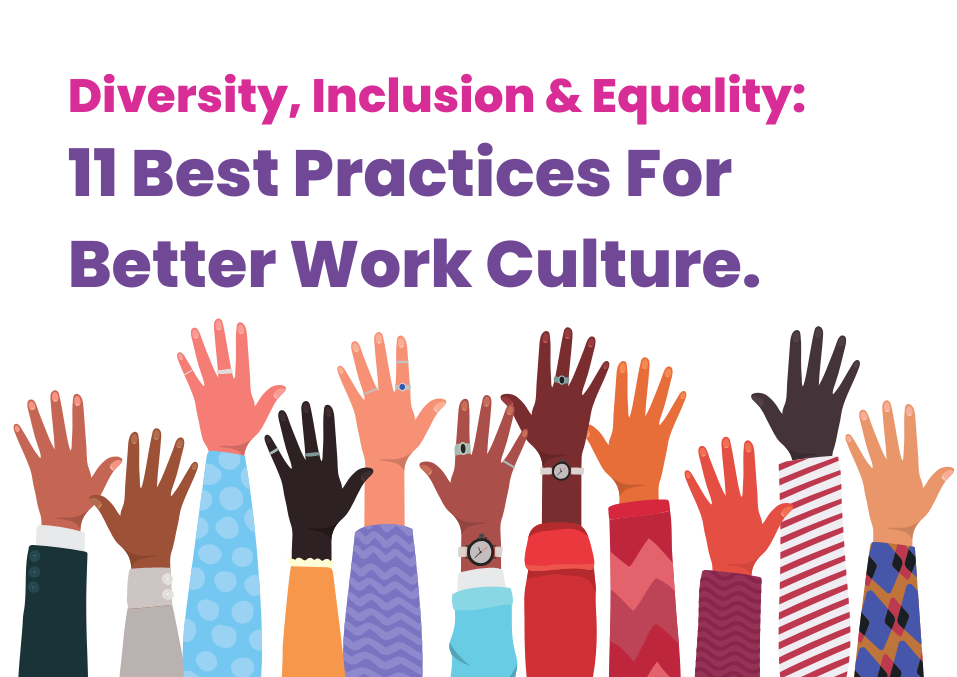Diversity, Equity, and Inclusion (DEI) at the workplace - Overview
Diversity, Equity, and Inclusion (DEI) at the workplace is now been considered by every giant industry in any field. Many companies have been practising diversity and inclusion in the workplace and have seen significant growth in revenue and, of course, their work culture as well. Diversity at the workplace brings a more respectful approach between the team members, and more to it; brainstorming will be at the next level among diverse people. Importance of Diversity, Equity and Inclusion (DEI) is numerous which we have already discussed earlier in the blog. Now discussing more inclusion, let us know what inclusion at the workplace means, policies that indicate inclusion at your workplace, the importance of DEI, and how to promote diversity, equity and inclusion (DEI) at workplace.
What is Inclusion in the workplace?
Inclusion in the workplace has been an ever-present ideology for organizations. But today, Implementing inclusion at the workplace has been one of the supreme challenges. It certainly is not impossible. However, several organizations that have figured out the diversity aspect but not Inclusion find it extremely difficult to make their workplace diversity inclusive. Fortunately, We have seen raised voices in seminars, conferences etc that are highlighting and advocating (based on studies conducted in many organizations) for practising diversity, Equity and Inclusion (DEI) at the workplace.
Importance of Diversity, Equity and Inclusion (DEI) in the workplace.
- One of the most significant achievements of Diversity, Equity and Inclusion (DEI) at the workplace is the retention of potential and talented manpower. Moreover, DEI at the workplace also attracts quality people at the time of hiring.
- An inclusive culture bring confidence in every individual that they have been heard and are considered. Diversity and inclusion empower diverse talent to participate enthusiastically in every progressive work of the organization.
- Inclusive cultures enable our colleagues to do things differently, working in ways that suit them and flexing working patterns to ensure their life-work balance is healthy and they can deliver their best for their organization.
- This focus on Inclusion equips our colleagues to make a difference in their well-being and the success of our organizations.
- In the changing world, Inclusion is imperative to future-proof our workplaces, of which many organizations are proud. However, in a true sense, Inclusion is a constant process that is always ongoing and about consistent learning.
11 Ways to Implement Diversity, Equity, and Inclusion at the workplace
- Educate Managers About Inclusion At The Workplace.
- Creating Inclusive Workplace Culture By Working on Workforce Policies
- Communicate Inclusion Goals And Measure Progress
- Celebrate Differences To Make Everyone Feel Included
- Diverse Opportunities For Employee Engagement
- Early Introduction To Inclusion (At Onboarding!)
- Make Pronouns Matter
- Diversity And Inclusion (D&I) Communication Channel
- Form A Diversity And Inclusion (D&I) Committee
- Meetings in which every opinion matters
- Tie D&I Efforts To Everyday Conversations
We have 11 best practices for diversity, equality, and inclusion (DEI) in the workplace; let us see the introspective points to identify whether your place is DEI-friendly or not.
8 Components that indicate Diversity and Inclusion in the workplace
-
Having A Voice
Sharing ideas is not a big deal for everyone but what brings confidence in everyone is when they are heard and considered.
-
-
Bonding with organization
When you give opportunities for suggestions and brainstorming, it’s not just you bring them confidence but is also connecting the bond between everyone and the organization.
-
Sense of Uniqueness
When someone is sharing their opinion, respect out of the box solution; no matter how much effective it is for you, it is about appreciation more than implementing ideas.
-
Feeling valued
A person cannot be more innovative and motivated than feel valued. Every individual is sharing their valuable input in the organization and should be valued for the same.
-
Learning & Development
Employees, when given opportunities to learn, enhance their skills and grow and know that their company cares about their ideas, growth, and success, the value addition by a resource in the organization boosts exponentially.
-
Collaborative environment
Working together towards one goal is the only goal of every individual of the organization. Irrespective of job roles/ positions and calibre of a person, An inclusive environment brings people to collaborate and work towards their ultimate goal.
-
Access to Resources
Given opportunities, every individual in the organization should be free to use every possible resource for their growth and learning.
-
Strategic Alignment
Somewhere in the foundation of an Inclusive environment in an organization, strategic alignment is to motivate team leaders, managers and higher management to know the value of an inclusive workplace and practice it wherever necessary/possible.
Conclusion
Inclusion is a process to execute diversity for its utmost outcome. Inclusion at the workplace makes everyone feel part of an organization that values their inputs, suggestions, and creativity, and every member’s minor contribution towards the company’s growth does matter. If you want to improve better work culture and makes your workplace more diverse and inclusive, Click here!

